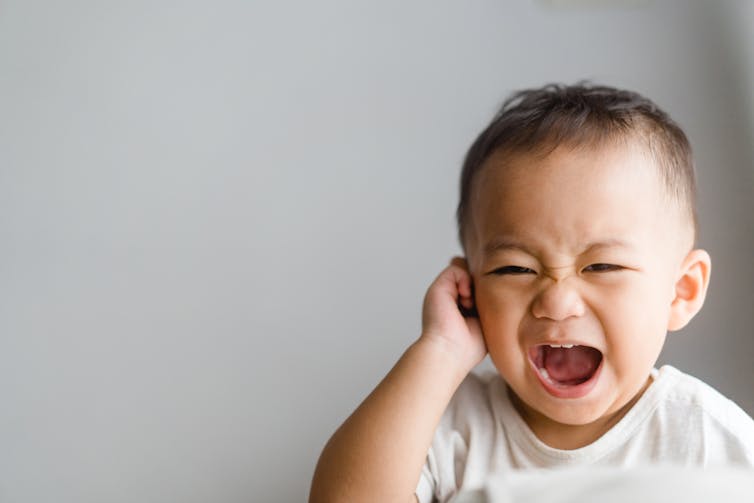Chiropractors in Australia will not be able to perform spinal manipulation on children under the age of two once more, following health concerns from doctors and politicians.
But what is the spinal treatment at the centre of the controversy? Does it work? Is there evidence of harm?
We’re a team of researchers who specialise in evidence-based musculoskeletal health. I (Matt) am a registered chiropractor, Joshua is a registered physiotherapist and Giovanni trained as a physiotherapist.
Here’s what the evidence says.
Remind me, how did this all come about?
A Melbourne-based chiropractor posted a video on social media in 2018 using a spring-loaded device (known as the Activator) to manipulate the spine of a two-week-old baby suspended upside down by the ankles.
The video sparked widespread concerns among the public, medical associations and politicians. It prompted a ban on the procedure in young children. The Victorian health minister commissioned Safer Care Victoria to conduct an independent review of spinal manipulation techniques on children.
Recently, the Chiropractic Board of Australia reinstated chiropractors’ authorisation to perform spinal manipulation on babies under two years old. But this week, it backflipped, following heavy criticism from medical associations and politicians.
What is spinal manipulation?
Spinal manipulation is a treatment used by chiropractors and other health professionals such as doctors, osteopaths and physiotherapists.
It is an umbrella term that includes popular “back cracking” techniques.
It also includes more gentle forms of treatment, such as massage or joint mobilisations. These involve applying pressure to joints without generating a “cracking” sound.
Does spinal manipulation in babies work?
Several international guidelines for health-care professionals recommend spinal manipulation to treat adults with conditions such as back pain and headache as there is an abundance of evidence on the topic. For example, spinal manipulation for back pain is supported by data from nearly 10,000 adults.
For children, it’s a different story. Safer Care Victoria’s 2019 review of spinal manipulation found very few studies testing whether this treatment was safe and effective in children.
Studies were generally small and were of poor quality. Some of those small, poor-quality studies, suggest spinal manipulation provides a very small benefit for back pain, colic and potentially bedwetting – some common reasons for parents to take their child to see a chiropractor. But overall, the review found the overall body of evidence was very poor.

However, for most other children’s conditions chiropractors treat – such as headache, asthma, otitis media (a type of ear infection), cerebral palsy, hyperactivity and torticollis (“twisted neck”) – there did not appear to be a benefit.
The number of studies investigating the effectiveness of spinal manipulation on babies under two years of age was even smaller.
There was one high-quality study and two small, poor quality studies. These did not show an appreciable benefit of spinal manipulation on colic, otitis media with effusion (known as glue ear) or twisted neck in babies.
Is spinal manipulation on babies safe?
In terms of safety, most studies in the review found serious complications were extremely rare. The review noted one baby or child dying (a report from Germany in 2001 after spinal manipulation by a physiotherapist). The most common complications were mild in nature such as increased crying and soreness.
However, because studies were very small, they cannot tell us anything about the safety of spinal manipulation in a reliable way. Studies that are designed to properly investigate if a treatment is safe typically include thousands of patients. And these studies have not yet been done.
Why do people see chiropractors?
Safer Care Victoria also conducted surveys with more than 20,000 people living in Australia who had taken their children under 12 years old to a chiropractor in the past ten years.
Nearly three-quarters said that was for treatment of a child aged two years or younger.
Nearly all people surveyed reported a positive experience when they took their child to a chiropractor and reported that their child’s condition improved with chiropractic care. Only a small number of people (0.3%) reported a negative experience, and this was mostly related to cost of treatment, lack of improvement in their child’s condition, excessive use of x-rays, and perceived pressure to avoid medications.
Many of the respondents had also consulted their GP or maternity/child health nurse.
What now for spinal manipulation in children?
At the request of state and federal ministers, the Chiropractic Board of Australia confirmed that spinal manipulation on babies under two years old will continue to be banned until it discusses the issue further with health ministers.
Many chiropractors believe this is unfair, especially considering the strong consumer support for chiropractic care outlined in the Safer Care Victoria report, and the rarity of serious reported harms in children.
Others believe that in the absence of evidence of benefit and uncertainty around whether spinal manipulation is safe in children and babies, the precautionary principle should apply and children and babies should not receive spinal manipulation.
Ultimately, high quality research is urgently needed to better understand whether spinal manipulation is beneficial for the range of conditions chiropractors provide it for, and whether the benefit outweighs the extremely small chance of a serious complication.
This will help parents make an informed choice about health care for their child.

